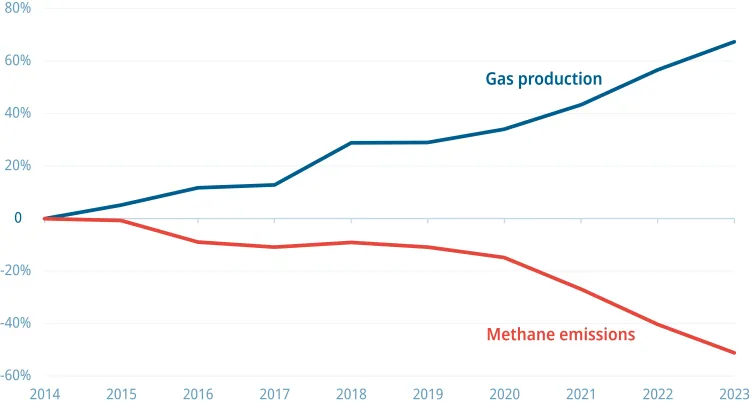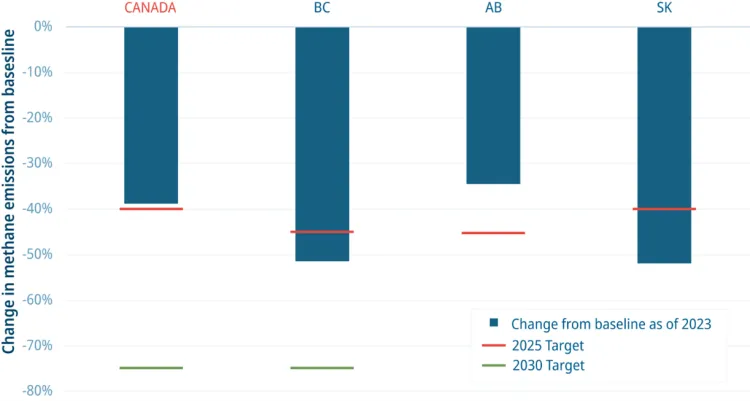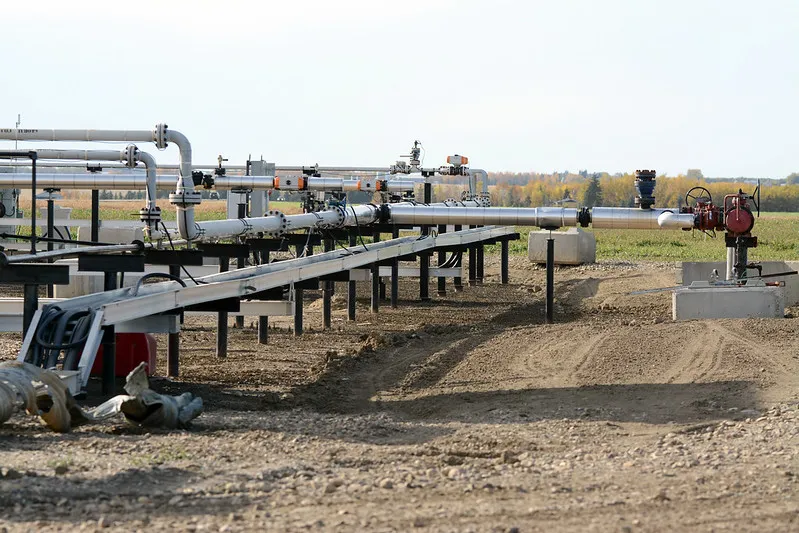VANCOUVER — British Columbia is the first jurisdiction in Canada to have met its 2025 oil and gas methane emissions reduction target, doing so two years ahead of schedule, according to new analysis from the Pembina Institute.
Notably, B.C. has achieved this while also growing oil and natural gas production, highlighting the fact that stringent methane regulations do not undermine the industry’s ability to operate. In fact, given the rising global trend of governments placing a premium on low-emissions energy imports, B.C.’s methane regulations are likely to boost the attractiveness of its oil and gas exports, bolstering the industry’s economic competitiveness in the years ahead.

Change in B.C.’s annual gas production versus methane emissions (from 2014 levels). Data sources: Canada Energy Regulator and Canada’s Official Greenhouse Gas Inventory
The finding comes from a new report, Raising the Bar: How targets and measurement are crucial to leadership on oil and gas methane, which examines international best practices on methane measurement and target setting, as well as progress to date by Canadian governments that have methane regulations in place.
The report argues that leading jurisdictions do not simply set targets and meet them, but assess their progress against best available measurement data – such as by integrating bottom-up industry emissions reporting with aerial measurements (data from sensors attached to airplanes). This means, where necessary, governments must revise up their inventories – including estimates for historical baseline years – and then reassess what level of action is needed.
In short, to credibly meet their targets, governments must commit to continuous improvement and transparency.
In this regard, B.C. again stands apart, as it has already begun to incorporate aerial measurement data into its emissions modelling and regulatory development. By comparison, though Alberta previously announced that it achieved its 2025 reduction target as of 2022, the federal National Inventory Report (which incorporates aerial measurement data) suggests it has not. This shows the importance of ensuring successes are backed by credible, transparent measurement data.
Meanwhile, though it appears Saskatchewan has also already achieved its expected 2025 reduction , this coincided with a decline in oil and gas production in the province . A separate study has also shown that methane intensity – i.e. amount of methane emitted per unit of oil and gas produced – is extraordinarily high in Saskatchewan, suggesting the province still has work to do to improve operational efficiency, and underscoring that this decrease in methane emissions is likely not attributable solely to regulation.

Progress of Canadian jurisdictions toward methane emissions targets (relative). Data source: Government of Canada.
Quotes
“B.C.’s success offers yet more evidence that methane emissions can be tackled without impeding the oil and gas industry’s operations. If anything, given the number of countries now considering new import standards that will privilege low-emissions energy products, stringent methane regulations – backed by transparent, best-in-class measurement data – are going to be key in bolstering the global competitiveness of our oil and gas sector.”
— Amanda Bryant, Senior Analyst, Pembina Institute
Quick facts
- Between 2014 (B.C.’s baseline year on which regulations are based) and 2023 (latest available data), B.C.’s natural gas production grew by 67%, while methane emissions associated with oil and gas production fell by 51%.
- This means B.C. achieved its 2025 methane target (of a 45% reduction from 2014 levels) two years early.
- Although the Government of Alberta announced that it achieved its 2025 reduction target as of 2022, latest data from the federal National Inventory Report – which incorporates more accurate aerial measurement data – suggests it has not.
- Meanwhile, Saskatchewan’s decrease in methane emissions is likely attributable at least in part to a fall in oil and gas production in the province, rather than to stringent regulations alone.
- Methane regulations are also the catalyst for a flourishing industry of Canadian methane abatement companies, which are providing jobs, investment and exportable technologies and expertise. A recent report commissioned by the Pembina Institute and Environmental Defense Fund found a total of 136 methane mitigation firms either headquartered in Canada or with sites (such as manufacturing facilities, sales offices, warehouses, repair shops) in Canada. These companies provide high-quality, well-paying jobs, with transferrable skills from the oil and gas sector.
Methane regulations: state of play
- In December 2023, the Government of Canada published the first draft of updated federal methane regulations, which aims to facilitate a 75% reduction of oil and gas sector methane emissions by 2030 (from 2012 levels).
- The new federal government has an opportunity to quickly follow-through on its campaign commitment to enact “enhanced final oil and gas methane regulations.”
- British Columbia has already released updated provincial regulations that aim to meet or exceed this federal target.
- The Government of Alberta has yet to issue strengthened regulations, but in its Emissions Reduction and Energy Development Plan, it committed to “assess potential pathways to achieve a provincial 75 to 80 per cent methane emissions reduction target from the conventional oil and gas sector by 2030 (from 2014 levels).”
[30]
Contact
Alex Burton
Communications Manager, Pembina Institute
825-994-2558
Background
Blog: B.C. meets its methane emissions target early
Report: Canada's Methane Opportunity: Innovation, Exports, Jobs
Blog: Action on methane makes sense now more than ever
Report: Success in Eliminating Methane in Alberta’s Peace River Region




